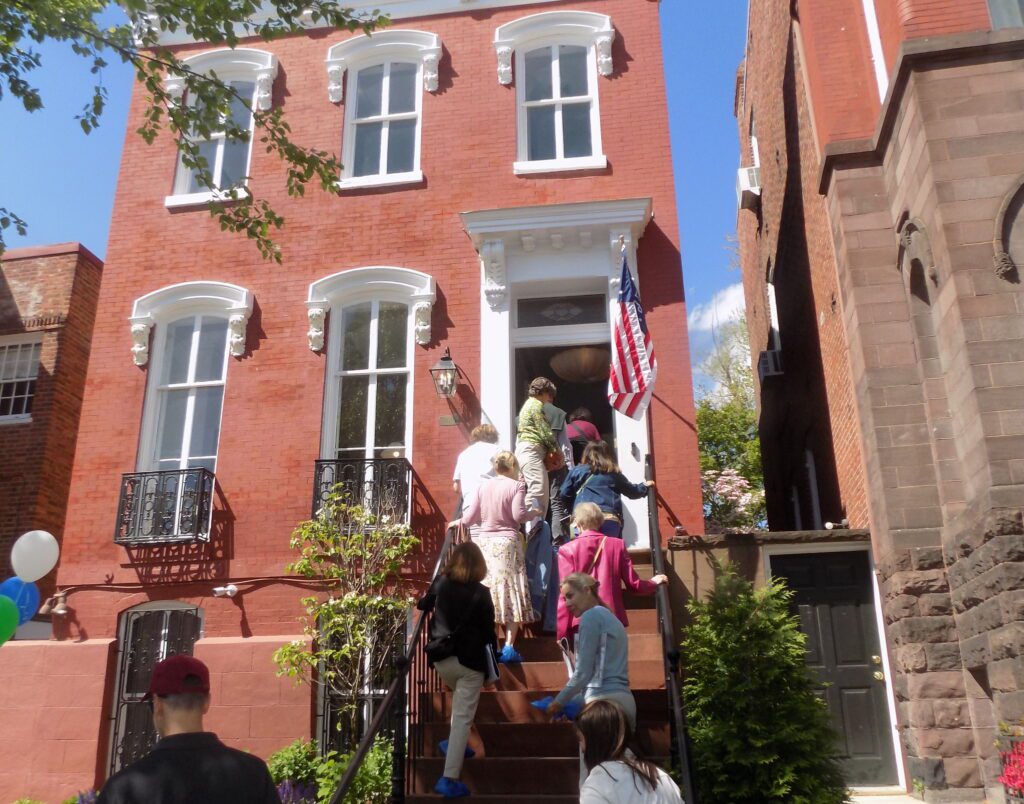91st Georgetown House Tour Shows Off Unique Renovations, Designs
By • April 22, 2024 0 427

More than 1,800 persons toured eight select homes on Saturday, April 20, during the 91st Georgetown House Tour, organized by St. John’s Episcopal Church at 3240 O St. NW and co-chaired by Azali Kassum and Donna Leanos.
The crowd flow went smoothly, the lines moved steadily despite a check-in at each house and chairs set out for tour goers to put on shoe coverings before entering each house, where they found knowledgeable and friendly docents in every room of every house.
The weather was sunny, clear and not too warm the whole day, making St. John’s Rector Gini Gerbasi laugh as she greeted hundreds of guests at the House Tour Tea held at the Parish Hall in the afternoon. “Last year I had to greet everyone with towels to help them dry off and to help spread out their umbrellas in the church entry hall,” she told The Georgetowner.
You would think after 91 years, seeing a multitude of mainly brick-facade Georgetown town houses, many dating over 100 years old, many with steep front steps, would get old despite the wonderful stories they contained of their often renowned past owners.
But every house had a surprise. What lay behind the historic front door often brought a gasp from the house tour guests when first entered. Almost all the homes had been remodeled — extensively, more than once — to modernize it with open spaces, larger rooms with lots of light, usually within the existing footprint.
Many of the houses had been completely gutted inside, to end up in some (as a home on Dent Place) with different levels for the entrance, living room, dining room and kitchen, family room adjoining garden. Almost all the homes had pantry-bars – some built in, such as a home on N Street, where the architect had opened the front walls of the dining room onto the living room and then fit in a large pantry bar and powder room behind. The dining rooms often had long narrow tables that could fit eight to12 people on open, airy, modern chairs.
Surprising to see as well was the select use of wallpaper in several of the houses. One on 28th Street used wall paper to unify the wall behind built-in bookcases and to hide a door to the cellar in the corner. Some textured wall paper was used on ceilings to bring out artistic shadows of the chandeliers. Several homes used it to enliven small powder rooms. Two homes used wall paper ingeniously to decorate their small home elevators.
One 100-plus year-old home owner kept the arched inset bookcases on either side of a paneled fireplace in the front room and converted it to a front office. That study opened up a large dining room with a wall of paneled windows over a long built-in shelf commode that used to house a large sink for the kitchen. But the owners had gotten permission to build an L-shaped wing with a pantry, modern kitchen and an octagonal breakfast room — one of the few houses that worked outside the original footprint.
Every house on the tour had a garden — maybe as a result of the pandemic of 2020. Some gardens were fitted out with large outdoor kitchens. One such garden kitchen in a house on P Street led to another patio with large comfortable couches and a TV. No vegetables nor cut flower beds were in sight, although it still might be too early to plant them.
Missing from most of the tour houses, however, were signs of the living mess of books, magazines, multiple TVs and art. One house that had a more lived-in look had patiently put all the kids toys on bookshelves and cabinets throughout the family room. A lively wall paper covered one wall; the interior wall had been opened fully to the living room with large settees facing a large TV set. It was a pleasure to see how the family’s activities were separated but together (and probably as neat for the house tour as it ever gets, which every parent on the tour could understand).
It was also a pleasure after seeing multiple houses to retreat to St. John’s Parish Hall for tea. There were hundreds of crustless sandwiches made by volunteers. Georgetown Cupcake contributed some 800 cupcakes, and Tatte Bakery (soon to open at the old Capital One building on the corner of Q Street and Wisconsin Avenue) contributed hundreds of pastries. There were plenty of chairs and tables and a fun jazz band.
Since 1931, St. John’s Episcopal Church has organized and hosted the Georgetown House Tour to raise funds for ministry and outreach. From day one, the House Tour has been an important part of enabling the mission of St John’s in the greater Georgetown community.

